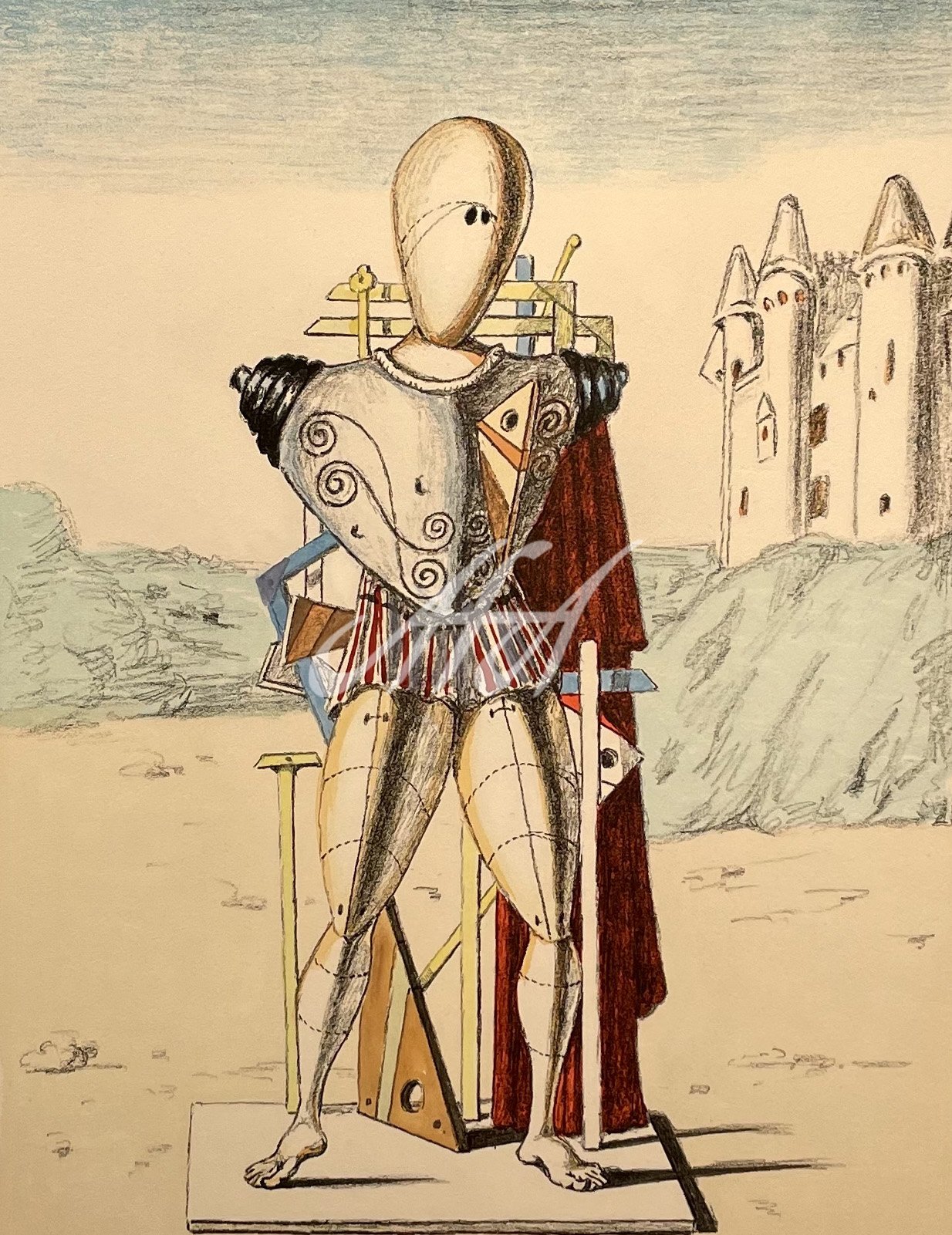Giorgio de Chirico
(Italian, 1888-1978)
“One must picture everything in the world as an enigma, and live in the world as if in a vast museum of strangeness.”
— Giorgio de Chirico
Painter Giorgio de Chirico is best known for his Metaphysical paintings from just before and during World War I. They significantly influenced later modern art movements including Surrealism, Dada, and German New Objectivity, and were among the most innovative works of their time. Chirico’s style changes considerably over time, but is always unmistakably his.
The artist’s parents were Italian but gave birth to him in Volos, Greece. He studied art at Athens Polytechnic under important and influential academic realist Greek painters of the late 19th-early 20th century such as Georgios Roilos and Georgios Jakobides. At age 18, he moved to Germany, the year after his father died. There he enrolled at the Academy of Fine Arts in Munich and studied under multiple influential artists such as Max Klinger, Arnold Böcklin, and Arthur Schopenhauer. In 1910, at age 22, Chirico moved to Florence, where he began his Metaphysical Town Square series. To a friend that year de Chirico wrote, “I’m the only man to have truly understood Nietzsche- all of my work demonstrates this.” Among Nietzsche’s many beliefs was that “man was an outsider in a godless world of alien and senseless things, where there are no obvious truths.” In Florence, he started using the style and imagery for which he is now famous - quiet, enigmatic, strangely simplified scenes of old towns. He then travelled to Paris, where he reunited with his brother, and met Pierre Laprade. Laprade was a member of the Salon d’Automne jury, which allowed de Chirico to exhibit at the Salon des Indépendants and Salon d’Automne. Pablo Picasso and Guillaume Apollinaire were among those who saw his works there. Apollinaire hailed de Chirico as “the most astonishing painter of our times,” and introduced him to Paul Guillaume, who would be his art dealer.
As an Italian citizen, the government expected him to do two years of military service, which he avoided by going to France. When the war started, he returned to Italy as they had offered amnesty to those deserters who came back and volunteered. Because of his highly sensitive temperament, the major of his assigned division classed him as medically unfit for service at the front and gave him a desk job, outside of which he painted. The result famously was a series of pictures created over the next three years, which would majorly affect the course of twentieth century art.
The settings for these compositions are often claustrophobic interiors or expansive, but largely isolated, exterior spaces with architectural elements. Within them are combinations of faceless dummies and a continual assortment of mysterious everyday objects- maps, bananas easels, fish- that leave dark, mystifying impressions. These apparently random collections actually conceal intentional elements with origins in classical, Judaic, and Christian symbols, which de Chirico tenaciously studied. De Chirico would later say, “Schopenhauer and Nietzsche were the first to teach me the non-sense of life and how such non-sense could be transmuted in art.” De Chirico, for a fleeting moment grabs hold of the meaning of existence, which remains an enigma and which he can only express as an enigma. Other esoteric devices used by the artist include illusory pictures within pictures and disembodied eyes - concepts that emerge again as strong, evocative components in the works of Dalí, Magritte, Man Ray, and Ernst. Surrealists greatly admired de Chirico’s work, and although he did not identify himself as a Surrealist, he did collaborate with and exhibit in their shows.
While word of his paintings was spreading rapidly through Europe, de Chirico exhibited his works in Rome in May 1918. Italian critics met them with collective opposition and an absolute lack of understanding, which affected him deeply. He adopted a neo-Baroque style, inspired by Rubens, leaving his metaphysical style behind. While his later paintings did not receive the same level of response as those from his metaphysical period, de Chirico believed his later work was superior and more developed. Still, towards the end of his life he did have a so-called Neo-Metaphysical phase in the late 1960s and early ‘70s. Near the end of his career, his styles became inconsistent and unpredictable.
Giorgio de Chirico passed away in Rome, aged 90, in 1978. He worked in many mediums including illustration, sculpture, and theatre design. His artistic contributions changed the face of modern art. His Metaphysical artwork especially affected Surrealism, and inspired numerous filmmakers, as unsettlingly deserted cityscapes were a motif adopted by a host of science-fiction directors. His piece, The Disquieting Muses, inspired Warhol to produce his own silkscreen takes on it, and a poem of the same name by Sylvia Plath.
American Fine Art, Inc. is proud to feature the original works and limited editions of Giorgio de Chirico. Visit our 12,000 sq. ft. showroom in Scottsdale, Arizona or call today. Our website is offered only as a limited place to browse or refresh your memory and is not a reflection of our current inventory. To learn more about collecting, pricing, value, or any other art information, an International Art Consultant will assist on giving you the one on one attention you deserve. We hope you find our website helpful and look forward to seeing you in Scottsdale soon.


